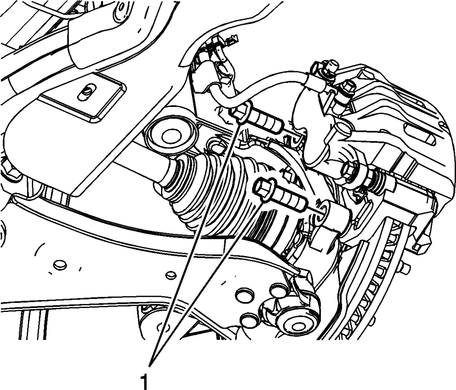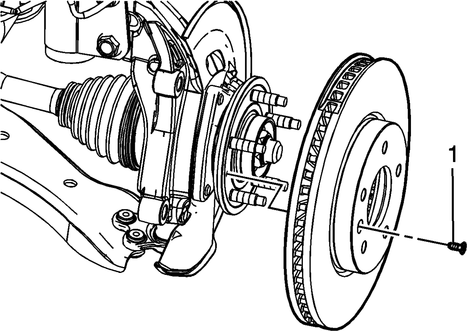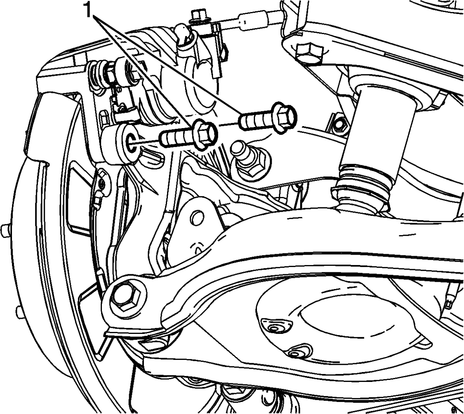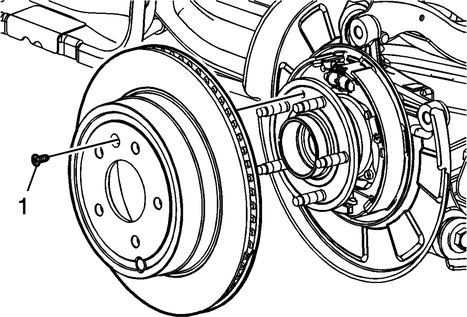Chevrolet Captiva Service & Repair Manual: Brake Rotor R&I
Front
Removal
| Caution: Support the brake
caliper with heavy mechanic wire, or equivalent, whenever it is separated
from its mount and the hydraulic flexible brake hose is still connected.
Failure to support the caliper in this manner will cause the flexible brake
hose to bear the weight of the caliper, which may cause damage to the brake
hose and in turn may cause a brake fluid leak. |
| 1. |
Raise and support the vehicle. |
| 2. |
Remove the tire and wheel assembly. |
| 3. |
Remove the brake caliper bracket bolts
(1), Fig. 1. |
| 4. |
Without disconnecting the brake caliper
hose, remove the brake caliper and bracket assembly and support
with heavy mechanics wire or equivalent. |
| 5. |
If installing the original brake rotor,
mark the relationship of the rotor to the wheel hub. |
| 6. |
Remove the brake rotor screw (1) and
the brake rotor, Fig. 2. |
| 7. |
If the brake rotor is to be machined,
check the thickness variation measurement. |
|
Installation
| If reusing the caliper bracket
bolts the threads of the caliper bracket bolts and the threads of the knuckle
mounting holes must be free of residue and debris prior to application of
threadlocker in order to ensure proper adhesion and fastener retention. |
| 1. |
If installing a new brake rotor, clean
the friction surfaces of the brake rotor with denatured alcohol. |
| 2. |
Using the CH-41450-A Wheel Hub Resurfacing
Kit, thoroughly clean any rust or corrosion from the mating surface
of the hub/axle flange. |
| 3. |
Using the CH-41013 Rotor Resurfacing
Kit, thoroughly clean any rust or corrosion from the mating surface
of the rotor to the hub/axle flange. |
| 4. |
If installing the original brake rotor,
align the rotor to the wheel hub as noted during removal. |
| 5. |
Install the brake rotor screw and
torque to 89 inch lbs. |
| 6. |
Position the brake caliper and bracket
assembly to the vehicle. |
| 7. |
Prepare the bolts and the threaded
holes for assembly, noting following: |
| |
a. |
Thoroughly clean the residue from the
bolt threads by using denatured alcohol or equivalent and allow
to dry. |
| |
b. |
Thoroughly clean the residue from the
threaded holes with denatured alcohol or equivalent and allow to
dry. |
| |
c. |
Apply threadlocker GM part No. 12345493,
or equivalent to 2/3 of the threaded length of the lower caliper
bracket bolts. |
| |
d. |
Ensure there are no gaps in the threadlocker
along the length of the filled area of the bolts. |
| |
e. |
Allow the threadlocker to cure approximately
10 minutes before installation. |
| 8. |
Install the brake caliper bracket bolts
and torque to 89 inch lbs. |
| 9. |
Install the tire and wheel assembly. |
|
Rear
Removal
| Caution: Support the brake
caliper with heavy mechanic wire, or equivalent, whenever it is separated
from its mount and the hydraulic flexible brake hose is still connected.
Failure to support the caliper in this manner will cause the flexible brake
hose to bear the weight of the caliper, which may cause damage to the brake
hose and in turn may cause a brake fluid leak. |
| 1. |
Raise and support the vehicle. |
| 2. |
Remove the tire and wheel assembly. |
| 3. |
Remove the brake caliper bracket bolts
(1), Fig. 3. |
| 4. |
Without disconnecting the brake caliper
hose, remove the brake caliper and bracket assembly and support
with heavy mechanics wire or equivalent. |
| 5. |
If installing the original brake rotor,
mark the relationship of the rotor to the wheel hub. |
| 6. |
Remove the brake rotor screw (1) and
the brake rotor, Fig. 4. |
| 7. |
If the brake rotor is difficult to
remove, remove the park brake shoe adjuster access plug on the face
of the brake rotor to gain access to the park brake adjuster. Loosen
the park brake shoe adjuster. |
| 8. |
If the brake rotor is to be machined,
check the thickness variation measurement. |
|
Installation
| If reusing the caliper bracket
bolts the threads of the caliper bracket bolts and the threads of the knuckle
mounting holes must be free of residue and debris prior to application of
threadlocker in order to ensure proper adhesion and fastener retention. |
| 1. |
If installing a new brake rotor, clean
the friction surfaces of the brake rotor with denatured alcohol. |
| 2. |
Using the CH-41450-A Wheel Hub Resurfacing
Kit, thoroughly clean any rust or corrosion from the mating surface
of the hub/axle flange. |
| 3. |
Using the CH-41013 Rotor Resurfacing
Kit, thoroughly clean any rust or corrosion from the mating surface
of the rotor to the hub/axle flange. |
| 4. |
If installing the original brake rotor,
align the rotor to the wheel hub as noted during removal. |
| 5. |
Install the brake rotor screw and
torque to 89 inch lbs. |
| 6. |
Position the brake caliper and bracket
assembly to the vehicle. |
| 7. |
Prepare the bolts and the threaded
holes for assembly, noting following: |
| |
a. |
Thoroughly clean the residue from the
bolt threads by using denatured alcohol or equivalent and allow
to dry. |
| |
b. |
Thoroughly clean the residue from the
threaded holes with denatured alcohol or equivalent and allow to
dry. |
| |
c. |
Apply threadlocker GM part No. 12345493,
or equivalent to 2/3 of the threaded length of the lower caliper
bracket bolts. |
| |
d. |
Ensure there are no gaps in the threadlocker
along the length of the filled area of the bolts. |
| |
e. |
Allow the threadlocker to cure approximately
10 minutes before installation. |
| 8. |
Install the brake caliper bracket bolts
and torque to 89 ft. lbs. |
| 9. |
If necessary, adjust the park brake. |
| 10. |
Install the tire and wheel assembly. |
|

Fig.
1

Fig.
2

Fig.
3

Fig.
4
Caution: Whenever brake rotor
has been separated from wheel bearing flange, clean any rust or foreign
material from mating surface of rotor and flange with a suitable hub cleaning
k ...
Front
Removal
Caution: Support the brake
caliper with heavy mechanic wire, or equivalent, whenever it is separated
from its mount and the hydraulic flexible brake hose is still connec ...




 Brake Rotor Deglaze
Brake Rotor Deglaze Brake Rotor R&R
Brake Rotor R&R